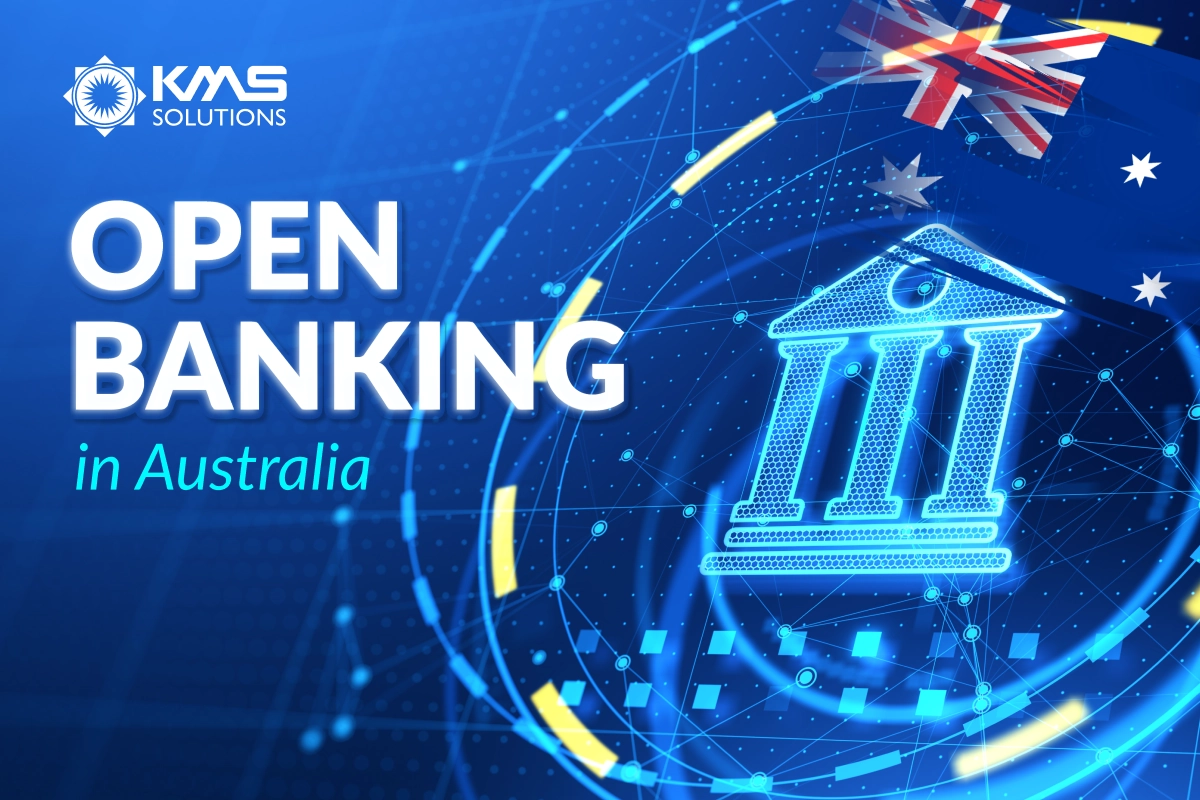Open banking is revolutionising the financial services industry across the world by promoting transparency, competition, and innovation, not to mention a greater degree of convenience and flexibility for both companies and users. In Australia, the ongoing introduction of open banking is set to transform how consumers interact with financial institutions and manage their finances.
In this article, our specialists at KMS Solutions explore the implementation of open banking in Australia, providing actionable insights for FinTech companies looking to develop open banking solutions.
What is Open Banking in Australia & Beyond?
Open Banking is a groundbreaking financial practice mandated by legislation, allowing consumers to share their personal and financial data with authorised third parties via application programming interfaces (APIs). By leveraging these capabilities, the approach fosters a collaborative data environment between financial institutions, which possess consumer information, and service providers, who utilise this data to develop innovative products and services, all with the consumer’s explicit consent.
The Introduction of Open Banking in Australia
Australia has proactively adopted open banking, with a clear regulatory framework and a phased implementation timeline.
Historical Context and Regulatory Framework on Open Banking Apps in Australia
The Australian government initiated the concept of open banking, which led to the establishment of the Consumer Data Right (CDR) in 2019. The CDR framework empowers consumers to control and share their data with accredited third parties, ensuring they can benefit from new financial products and services.
Open Banking Australia Timeline & Implementation
In the rollout of open banking in Australia, the process was broken down into three phases:
- Phase 1: Savings accounts, Term deposits, Debit and credit cards, Cheque accounts, Current accounts, Basic accounts, and Transaction accounts.
- Phase 2: Mortgages, Personal loans, and Mortgage offset accounts.
- Phase 3: Business finance, Investment loans, Retirement accounts, Foreign currency accounts, Joint accounts, Trust accounts, Home loans, and Overdrafts.
Key Milestones
- Establishment of the CDR legislation, establishing the legal foundation for data sharing.
- Development of technical standards for data sharing, ensuring secure and standardised data exchange.
- Rollout phases for different types of financial data and institutions, gradually expanding the scope of open banking.
Key Benefits of Open Banking for Australians
Open banking works through APIs, which allow different software systems to communicate and share data securely. This interoperability is crucial for creating a cohesive and efficient financial ecosystem where various applications can work together seamlessly.
Open banking generates new opportunities for all participants and offers advantages to everyone involved.
Benefits of Open Banking for Users
- Simplifies Switching Banks: Open banking allows customers to authorize the transfer of their financial data from their old bank to their new one through secure APIs. This means account details, transaction histories, and direct debits can be transferred quickly and accurately without the need for manual input.
- Enhances Financial Analysis: Provides data that can be used to analyse, optimise, and improve your financial situation.
- Facilitates New Account Sign-ups: Open banking facilitates the electronic Know Your Customer (e-KYC) process by allowing new banks to access verified customer information from the old bank, reducing the need for redundant identity checks. It also simplifies the process of signing up for new credit or debit cards.
- Manages Joint Accounts: Streamlines the management of joint accounts, allowing co-account holders to see their combined financial status in one place, including balances, transactions, and budgets.
- Supports Investment Loan Applications: With the capability of seamless data transfer, users can share their financial data through APIs, eliminating the need for manual document gathering and submission.
- Improves Financial Wellness: Open banking provides users with a holistic view of their financial status, expense tracking, and personalized financial guidance. This empowers users to make informed decisions, achieve their financial goals, and maintain financial health.
Benefits for FinTech, Banks, and Other Organisations
- Empowers the Financial Services Industry: Open banking fosters collaboration between traditional financial institutions, FinTech companies, and other industry players, creating vibrant ecosystems that drive innovation and value creation. Banks and FinTech companies can collaborate to create new solutions for users
- Encourages Competition: Challenges the status quo, enabling smaller companies and financial institutions to compete equally with major banks.
- Facilitates Data Sharing: Simplifies consumer data sharing between traditional data holders (e.g., banks) and accredited third parties.
- Promotes Innovation: Developers can leverage rich data sources to introduce innovative solutions and personalised financial products and services.
- Levels the Playing Field: Allows smaller banks and FinTechs to compete with larger counterparts.
Regulatory Environment and Compliance
The regulatory environment for open banking in Australia is primarily overseen by the Australian Competition and Consumer Commission (ACCC) and the Office of the Australian Information Commissioner (OAIC).
Open banking generates new opportunities for all participants and offers advantages to everyone involved.
Key Regulations and Compliance Requirements
- Consumer Data Right (CDR): Central regulation that governs data sharing and protection, giving consumers control over their data.
- Data Standards Body: Develops the technical standards for API implementations, ensuring secure and efficient data exchange.
- Accreditation Requirements: Fintech companies must be accredited to participate in open banking, ensuring they meet stringent security and privacy standards.
Importance of Adhering to Regulatory Standards
Compliance with these regulations is crucial for building trust with consumers and ensuring the security and integrity of financial data. Adhering to regulatory standards also helps Fintech companies avoid legal issues and potential penalties.
How Banks and Fintech Companies in Australia Adopted Open Banking?
In recent years, the Australian financial technology industry has experienced notable expansion, with numerous prominent entities emerging as frontrunners in the domain of open banking. Frollo reported that by 2023, almost every bank was actively sharing data across over 30 diverse financial products, with the number of entities making use of this data having doubled in the previous year.
Banks and Fintech companies that have adopted open banking APIs include:
- Up – a digital bank operating under Bendigo and Adelaide Bank’s ADI – utilizes open banking APIs to provide customers with features such as real-time transaction details, automatic expense categorization, and tailored spending insights.
- Macquarie Bank’s devExchange open APIs platform allows users to share their banking data, such as account information, transactions, balance, etc., with third-party entities without providing login credentials.
Developing Open Banking Solutions in Australia with KMS Solutions
For Fintech companies, developing open banking solutions involves several technical and strategic considerations, including:
- Secure and Reliable APIs: Ensure seamless and secure data exchange between systems. APIs must be robust and capable of handling large volumes of data without compromising security.
- Robust Authentication Mechanisms: Implement robust security protocols to protect user data. This includes encryption, multi-factor authentication (MFA), and other advanced security measures.
- Data Encryption: Encryption safeguards data both in transit and at rest, ensuring that sensitive information remains protected at all times.
- Regulatory Compliance: As mentioned above, ensuring compliance with regulations such as the Consumer Data Right (CDR) in Australia is crucial for safeguarding consumer data and maintaining trust.
- Customer Consent Management: Banks and financial institutions must obtain explicit consent from customers before sharing their data with TPPs. This ensures that customers remain in control of their personal information and can withdraw consent at any time.
- Developer Portals: Provide resources and tools necessary for building and testing Open Banking applications.
If you want to learn more about digital banking systems transformation, contact us at KMS Solutions today.








